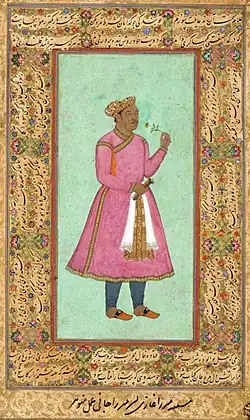Mirza Ghazi Beg
| Mirza Ghazi Beg | |||||
|---|---|---|---|---|---|
| Mirza Ghazi Beg | |||||
 "Likeness of Mirza Ghazi, son of Mirza Jani". Made by Manohar Das, a Mughal painter at the Tarkhan Court in the province of Thatta, circa 1610.[1] | |||||
| 3rd Subahdar of Thatta Subah | |||||
| Reign | 1 February 1601 – 12 April 1612 | ||||
| Predecessor | Jani Beg | ||||
| Successor | Muzaffar Khan Mamuri | ||||
| Born | 1584 Thatta, Sindh Sultanate | ||||
| Died | 12 April 1612 (aged 28) Thatta, Thatta Subah, Mughal Empire (present day Thatta, Sindh, Pakistan) | ||||
| |||||
| House | Tarkhan dynasty | ||||
| Father | Mirza Jani Beg Tarkhan | ||||
| Religion | Shia Islam | ||||
Mirza Ghazi Beg (c. 1584–1612 CE) of the Turkic Tarkhan dynasty in Sindh ruled from the capital city of Thatta. Beg was a son of Mirza Jani Beg Tarkhan, the last autonomous Tarkhan ruler, who had later continued to rule as Governor for the Mughals.[2]
Mirza Jani submitted to the Mughal emperor Akbar and became a loyal supporter of the emperor. His son, Ghazi Beg led the Mughal army in major campaigns in the early years of Jahangir's reign.[2]
In Sindh a network of small and large forts manned by cavalry and musketeers further extended Mughal power during the reign of Mughal Emperor Shah Jahan.[3][4]
References
- ^ Museum, Victoria and Albert (1610). "Mirza Ghazi Manohar V&A Explore The Collections". Victoria and Albert Museum: Explore the Collections.
- ^ a b Museum, Victoria and Albert (1610). "Mirza Ghazi by Manohar V&A Explore The Collections". Victoria and Albert Museum: Explore the Collections.
- ^ The Cambridge History of Southeast Asia by Nicholas Tarling p.39
- ^ Cambridge illustrated atlas, warfare: Renaissance to revolution, 1492-1792 by Jeremy Black p.16 [1]